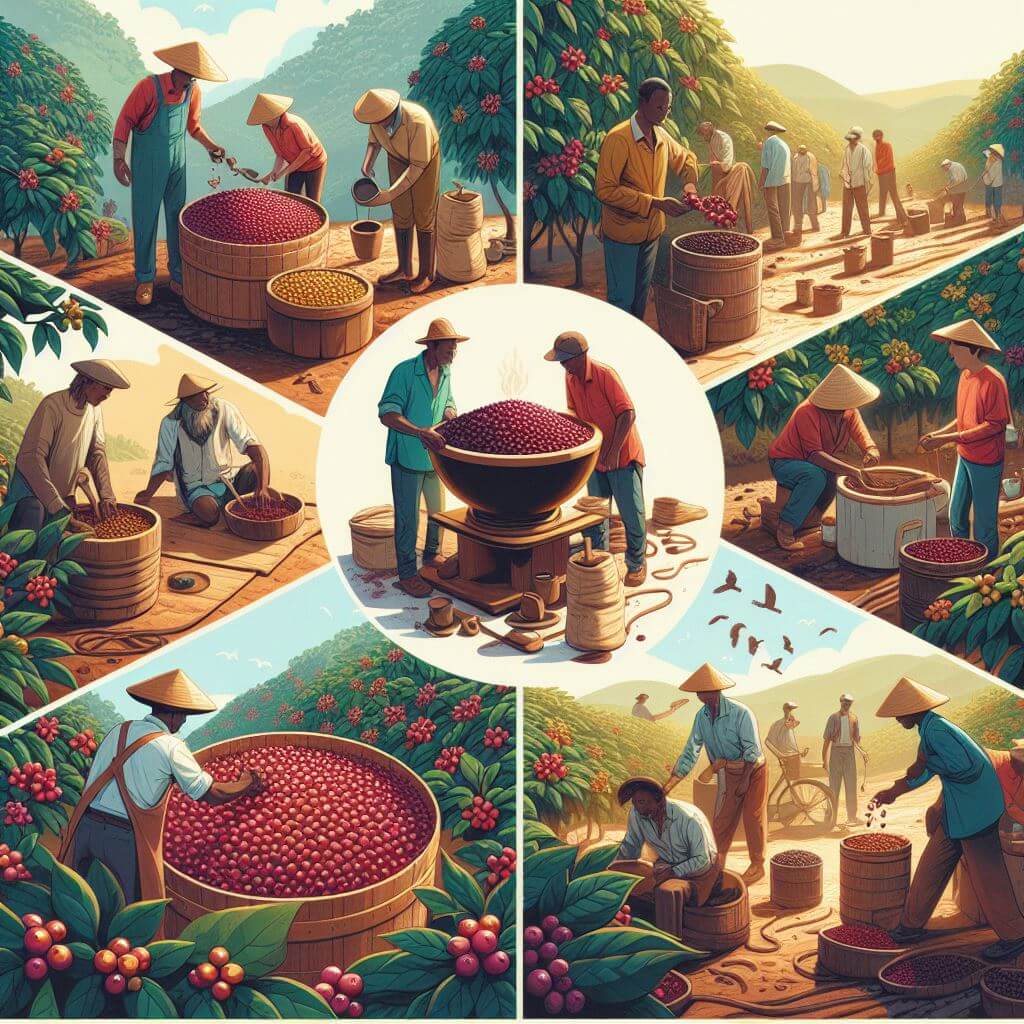
The history of coffee in Costa Rica dates back to the end of the 18th century. Introduced in 1779 from Cuba, coffee plants have found an ideal home in the country’s fertile volcanic soil and favorable climate. This initial introduction was relatively small and experimental as local farmers began to understand the potential of the crop. By the 1820s, coffee had begun to be grown for export, and by 1831, this had brought Costa Rica its first small economic boom, known as the “Golden Beans” era. The government, recognizing the export potential, offered free land to coffee growers, promoting exponential growth in coffee production.
In 1832, the Costa Rican government took a bold step to promote coffee cultivation by offering incentives and land grants to farmers who wanted to grow coffee. This not only accelerated the cultivation of coffee but also encouraged the migration of settlers to new regions, further expanding agricultural frontiers. Coffee’s journey from farm to market has been facilitated by the construction of vital infrastructure. One notable development was the establishment of the Pacific Railroad in 1846, which connected the coffee-producing regions to the Pacific port of Puntarenas. This railway made a difference, greatly reducing transport costs and time, and allowing for more efficient exports.
By 1846, coffee from Costa Rica had made its way to Britain, which became a significant market for high-quality coffee. The combination of Costa Rican coffee production and British demand was a tipping point that led to an aggressive expansion of coffee farms in the Central Valley and beyond. The infusion of capital from coffee exports fueled the development of San Jose, turning it into a bustling metropolitan center.
As the coffee industry flourished, Costa Rica became heavily dependent on agricultural exports, and coffee became the backbone of the national economy. During this period, a socioeconomic class known as the “coffee barons” emerged that played an influential role in Costa Rica’s political and social landscape. Their wealth and influence led to investment in public infrastructure, including schools, hospitals, and public buildings, thereby contributing to national development.
The robust infrastructure developed during this period included not only roads and railways but also processing plants known as “beneficial”. These engineering facilities, such as the famous Juan Viñas mill, founded at the end of the 19th century, revolutionized coffee processing through the use of wet grinding technologies that increased efficiency and preserved the quality of the beans. Beneficios were often the epicenters of local communities, contributing to economic growth and creating employment opportunities.
Costa Rica’s commitment to coffee production was confirmed by the creation of the Instituto del Café de Costa Rica (ICAFE) in 1933. This institute was to oversee all aspects of coffee production, from research and development to quality control and marketing. ICAFE has played a critical role in modernizing the industry by introducing advanced farming practices, pest control measures, and innovative processing methods.
In the late 20th and early 21st centuries, Costa Rica adapted to global trends in coffee consumption. The rise of specialty coffee on the international market has prompted Costa Rican farmers to focus on quality and sustainability. Emphasis was placed on the production of high-altitude single-origin coffee known for its unique flavor profiles. This change was supported by certifications such as Fair Trade, Rainforest Alliance, and organic labeling, which strengthened Costa Rica’s reputation as a producer of premium coffee.
Growing Practices And Unique Varieties
Costa Rica’s diverse geography and microclimate create an ideal environment for growing high-quality Arabica coffee. The country strictly adheres to the cultivation of Arabica coffee through national legislation, ensuring the highest production standards. This legal framework sets Costa Rica apart from many other coffee-producing countries, as it prohibits the cultivation of the less complex and low-quality Robusta coffee. This guarantee has helped maintain Costa Rica’s reputation as a premium coffee producer.
The regions of Tarrazu, Tres Rios, Heredia, Alajuela, and the Central Valley are among the most famous, each producing coffee with distinct flavor profiles dependent on specific altitude, climate, and soil type. For example, the Tarrazu region, often referred to as the “Land of the Saints,” is known for its high-altitude farms that produce coffee with bright acidity and a rich, complex flavor. The area benefits from a dry harvest season, ideal for producing high-quality coffee cherries. In contrast, the Central Valley offers a more balanced climate, producing coffee with a softer body and balanced acidity.
Growing coffee in Costa Rica is a painstaking process that relies heavily on traditional methods that prioritize quality over quantity. Farmers usually use the shade cultivation method, which involves growing coffee plants under the canopy of native trees. This practice not only improves the taste of the beans but also helps preserve the ecosystem by promoting biodiversity and reducing the need for chemicals. The microclimate created by the shade contributes to the slow ripening of coffee cherries, which leads to more complex flavors in the beans.
Soil health is another important factor in growth. Costa Rican farmers take advantage of the country’s rich volcanic soil, which provides essential minerals and nutrients that support the health of coffee plants. Soil fertility is often maintained through sustainable practices such as crop rotation and the use of organic compost. Microorganisms and earthworms are encouraged to thrive in the soil, ensuring it remains aerated and rich in nutrients, which in turn supports strong coffee plant growth.
The coffee cherries are hand-picked during the harvest season, ensuring that only the ripe ones are picked. This labor-intensive process reflects Costa Rican farmers’ commitment to quality. Picking by hand reduces the chance of unripe or overripe cherries being included in the batch, potentially compromising flavor. Harvesting usually takes place between November and March, depending on the region and altitude. Many farms rely on the same families to harvest year after year, helping to develop generational craftsmanship and sustain community livelihoods.
After harvesting, the beans undergo a wet processing method that involves removing the pulp and fermenting the beans to remove residual mucilage. This method, also known as the rinsing process, is known for making cups of coffee cleaner and brighter, bringing out the natural flavors of the beans. During fermentation, careful monitoring ensures that the beans develop the desired flavor characteristics without over-fermentation. The beans are then washed and dried in the sun in large patios or raised drying beds, allowing for a natural reduction in moisture content.
Coffee growers in Costa Rica take particular pride in experimenting with different coffee varieties and growing techniques. Caturra, Catuai, and Gesha varieties are usually grown. Caturra and Catuai are known for their longevity and consistency of flavor, while Gesha, although more difficult to grow, has gained international recognition for its distinctive floral and jasmine attributes. Each variety is carefully selected and cultivated to obtain the best flavor profiles adapted to the specific growing conditions of each region.
Economic Influence And World Recognition
Coffee production is important to Costa Rica’s economy, employing hundreds of thousands of people and contributing significantly to the country’s GDP. The coffee industry supports small farmers as well as large estates, contributing to economic stability and growth in both rural and urban areas.
Costa Rican coffee has earned worldwide recognition for its exceptional quality and excellent characteristics. Its reputation for excellence has been recognized by numerous international awards and certificates. The Costa Rican Specialty Coffee Association plays a key role in maintaining these high standards, maintaining strict quality control measures, and promoting Costa Rican coffee on the world stage.
Export occupies a central place in the coffee economy. Coffee beans are carefully processed and sorted according to international quality standards before being sent to markets in Europe, the United States, and Asia. The high demand for Costa Rican coffee in these markets is a testament to its premium quality and rich flavor.

